
Cannondale Historic District is a historic district in the Cannondale section in the north-central area of the town of Wilton, Connecticut. The district includes 58 contributing buildings, one other contributing structure, one contributing site, and 3 contributing objects, over a 202 acres (82 ha). About half of the buildings are along Danbury Road and most of the rest are close to the Cannondale train station .The district is significant because it embodies the distinctive architectural and cultural-landscape characteristics of a small commercial center as well as an agricultural community from the early national period through the early 20th century....The historic uses of the properties in the district include virtually the full array of human activity in this region—farming, residential, religious, educational, community groups, small-scale manufacturing, transportation, and even government. The close physical relationship among all these uses, as well as the informal character of the commercial enterprises before the rise of more aggressive techniques to attract consumers, capture some of the texture of life as lived by prior generations. The district is also significant for its collection of architecture and for its historic significance.
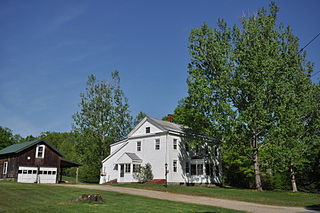
The Sibley–Corcoran House is a historic house at 387 Upper Valley Road in Washington, Massachusetts. Built about 1813, it is a well-preserved example of a rural Federal style farmhouse, with later Greek Revival alterations. The house was listed on the National Register of Historic Places on September 12, 1986.

The Nathaniel Backus House is a two-story Greek Revival clapboarded house with a gable roof in Norwich, Connecticut. The house was built around 1750 by Nathaniel Backus and served as his home, it was later moved to its current location in 1952. The house originally began as a Colonial, but was greatly modified to Greek Revival around 1825, reconfiguring the central door to the left of the facade and adding two chimneys. The house is a historic house museum operated by the Faith Trumbull Chapter of the Daughters of the American Revolution.

St. George's Catholic Church is a historic church and school building on Vermont Route 25 in Bakersfield, Vermont. Built in 1840, it housed the South Academy until 1888, when it was purchased by the Roman Catholic Diocese of Burlington. It served as a church until 1996, and has since then housed the local historical society. It is a prominent local example of Gothic Revival architecture, and was listed on the National Register of Historic Places in 2001.

The Dr. Daniel Adams House is a historic house at 324 Main Street in Keene, New Hampshire. Built about 1795, it is a good example of transitional Federal-Greek Revival architecture, with a well documented history of alterations by its first owner. The house was listed on the National Register of Historic Places in 1989.

The Smith–Emery House is a historic house at 400 Main Street in the Springvale village of Sanford, Maine. Built in 1847, it is one of Sanford's largest and finest examples of Greek Revival architecture, and was owned by two prominent local businessmen. It was listed on the National Register of Historic Places in 1998.

The Dr. J. Porter House is a historic house at 391 Belleview Avenue in Southington, Connecticut. Estimated to have been built about 1728, it is one of the town's few surviving 18th-century houses. It was home from 1754 home to one of the town's largest landowners. It was listed on the National Register of Historic Places in 1989.

The Woodruff House is a historic house at 377 Berlin Street in Southington, Connecticut. Built about 1780, it is a well-preserved example of an 18th-century Cape with later Greek Revival styling. It was listed on the National Register of Historic Places in 1989.

The Enfield Town Meetinghouse is a historic Greek Revival style meeting house located on Enfield Street at South Road in Enfield, Connecticut. Completed in 1775 and moved and restyled in 1848, it hosted the municipal government until the 1920s. Now managed by the local historical society as a museum, it was listed on the National Register of Historic Places in 1974.

The Fowler-Steele House, also known historically as Ivy Hall, is a historic house on North Main Street in Windsor, Vermont, United States. Built in 1805 and restyled about 1850, it has an architecturally distinctive blend of Federal and Greek Revival styles. It served for many years as a local church parsonage. It was listed on the National Register of Historic Places in 1982.
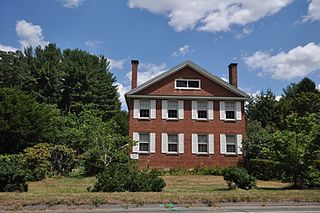
The Benomi Case House is a historic house at 436 Rainbow Road in Windsor, Connecticut. Built in 1834, it is one of the town's finest examples of Greek Revival architecture in brick. It was listed on the National Register of Historic Places in 1988.
The Abraham Coult House is a historic house at 1695 Hebron Avenue in Glastonbury, Connecticut. Built about 1706 and enlarged several times, it is a well-preserved colonial residence, exhibiting changing construction methods through its alterations. Moved in the 1970s to avoid demolition and restored, it was listed on the National Register of Historic Places in 2000.

The Gordon Loomis House is a historic house at 1021 Windsor Avenue in Windsor, Connecticut. Built in 1835, it is a good local example of transitional Federal-Greek Revival architecture executed in brick. It was listed on the National Register of Historic Places in 1988.
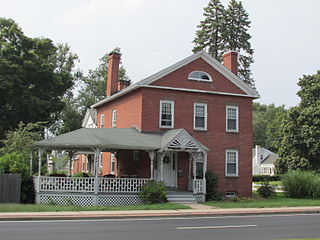
The Ira Loomis Jr. House is a historic house at 1053 Windsor Avenue in Windsor, Connecticut. Built in 1833, it is a good local example of transitional Federal-Greek Revival architecture executed in brick. It was listed on the National Register of Historic Places in 1988.

The Elisha Seymour Jr. House is a historic house at 410-412 Park Road in West Hartford, Connecticut. Built about 1770, it is one of the town's few surviving pre-independence brick buildings. it was listed on the National Register of Historic Places in 1986.

The Daniel Payne House is a historic house at 27 Park Avenue in Windsor, Connecticut. Built about 1830, it is a well-preserved example of a brick house with Greek Revival styling. It was listed on the National Register of Historic Places in 1988.

The William Shelton House is a historic house at 40 Pleasant Street in Windsor, Connecticut. Built in 1830, it is a good local example of transitional Federal-Greek Revival architecture executed in brick. It was listed on the National Register of Historic Places in 1988.
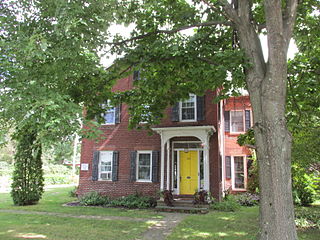
The Sophia Sweetland House is a historic house at 458 Palisado Avenue in Windsor, Connecticut. Built about 1845, it is a good local example of transitional Greek Revival-Italianate architecture executed in brick. It was listed on the National Register of Historic Places in 1988.

The Treadwell House is a historic house at 253 Spielman Highway in the center of Burlington, Connecticut. Built about 1810 for John Treadwell, then the Governor of Connecticut, it is a distinctive local example of Federal period architecture with Greek Revival overlay features. It was listed on the National Register of Historic Places in 1982. It is now used for commercial purposes.
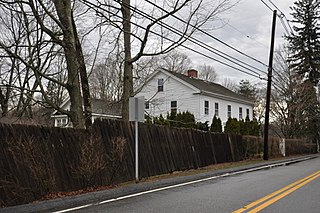
The Isaac Hoadley House is a historic house at 9 Totoket Road in Branford, Connecticut. Built in 1757, it is a well-preserved example of Georgian residential architecture, with later Greek Revival features added. It was listed on the National Register of Historic Places in 1988.





















